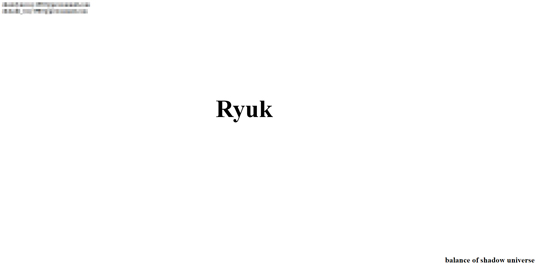Ransom.Win32.RYUK.HUG
Windows


Threat Type: Ransomware
Destructiveness: No
Encrypted: Yes
In the wild: Yes
OVERVIEW
This Ransomware arrives on a system as a file dropped by other malware or as a file downloaded unknowingly by users when visiting malicious sites.
It drops files as ransom note. It avoids encrypting files with the following file extensions.
TECHNICAL DETAILS
Arrival Details
This Ransomware arrives on a system as a file dropped by other malware or as a file downloaded unknowingly by users when visiting malicious sites.
Installation
This Ransomware drops the following copies of itself into the affected system:
- {malware path}\{random}.exe
It drops the following files:
- %System Root%\Document and Settings\Default User\window.bat -> deletes shadow copies and backup
- %User Startup%\start.bat -> deletes shadow copies, backup
- %User Startup%\RyukReadMe.html -> ransom notes
- %Common Startup%\start.bat -> deletes shadow copies, backup
(Note: %System Root% is the Windows root folder, where it usually is C:\ on all Windows operating system versions.. %User Startup% is the current user's Startup folder, which is usually C:\Windows\Profiles\{user name}\Start Menu\Programs\Startup on Windows 98 and ME, C:\WINNT\Profiles\{user name}\Start Menu\Programs\Startup on Windows NT, C:\Documents and Settings\{User name}\Start Menu\Programs\Startup on Windows 2003(32-bit), XP and 2000(32-bit), or C:\Users\{user name}\AppData\Roaming\Microsoft\Windows\Start Menu\Programs\Startup on Windows Vista, 7, 8, 8.1, 2008(64-bit), 2012(64-bit), 10(64-bit).. %Common Startup% is the startup folder for all users, which is usually C:\Documents and Settings\All Users\Start Menu\Programs\Startup on Windows 2000, XP, and Server 2003, or C:\ProgramData\Microsoft\Windows\Start Menu\Programs\Startup on Windows Vista, 7, and 8.)
Other Details
This Ransomware does the following:
- It executes its copy having the following parameters:
- {malware path}\{random}.exe 8 LAN
- It searches for the following string in the machine's services. If the string is present in the service name, it will terminate the service by the following command "net stop "{service name}" /y":
- back
- xchange
- ackup
- acronis
- sql
- enterprise
- sophos
- veeam
- acrsch
- antivirus
- bedbg
- dcagent
- epsecurity
- epupdate
- eraser
- esgshkernel
- fa_scheduler
- iisadmin
- imap4
- mbam
- endpoint
- afee
- mcshield
- task
- mfemms
- mfevtp
- mms
- msdts
- exchange
- ntrt
- pdvf
- pop3
- report
- resvc
- sacsvr
- savadmin
- sams
- sdrsvc
- sepmaster
- monitor
- smcinst
- smcservice
- smtp
- snac
- swi_
- ccsf
- truekey
- tmlisten
- ui0detect
- w3s
- wrsvc
- netmsmq
- ekrn
- ehttpsrv
- eshasrv
- avp
- klnagent
- wbengine
- kavf
- mfefire
- bootmgr
- It terminates processes having the following strings, it uses "taskkill /IM /F {Process Name}" to terminate:
- backup
- xchange
- sql
- dbeng
- sofos
- calc
- ekrn
- zoolz
- encsvc
- excel
- firefoxconfig
- infopath
- msaccess
- mspub
- mydesktop
- ocautoupds
- ocomm
- ocssd
- onenote
- oracle
- outlook
- powerpnt
- sqbcoreservice
- steam
- synctime
- tbirdconfig
- thebat
- thunderbird
- visio
- word
- xfssvccon
- tmlisten
- pccntmon
- cntaosmgr
- ntrtscan
- mbamtray
- veeam
- Injects to all running processes except for the following:
- explorer.exe
- csrss.exe
- lsaas.exe
- {Malware Filename}.exe
- The ransomware locks the machine once done encrypting.
Rogue Antivirus Routine
This Ransomware avoids encrypting files with the following strings in their file name:
- RyukReadMe.html
- UNIQUE_ID_DO_NOT_REMOVE
- PUBLIC
- sysvol
- netlogon
- PRIVATE
It avoids encrypting files with the following strings in their file path:
- \Windows\
- AhnLab
- Chrome
- Mozilla
- $Recycle.Bin
- WINDOWS
It appends the following extension to the file name of the encrypted files:
- .RYK
It drops the following file(s) as ransom note:
- {Encrypted Directory}\RyukReadMe.html

It avoids encrypting files with the following file extensions:
- .dll
- .exe
- .ini
- .lnk
- hrmlog
SOLUTION
Step 1
Trend Micro Predictive Machine Learning detects and blocks malware at the first sign of its existence, before it executes on your system. When enabled, your Trend Micro product detects this malware under the following machine learning name:
- Troj.Win32.TRX.XXPE50FFF033
Step 2
Before doing any scans, Windows 7, Windows 8, Windows 8.1, and Windows 10 users must disable System Restore to allow full scanning of their computers.
Step 3
Note that not all files, folders, and registry keys and entries are installed on your computer during this malware's/spyware's/grayware's execution. This may be due to incomplete installation or other operating system conditions. If you do not find the same files/folders/registry information, please proceed to the next step.
Step 4
Restart in Safe Mode
Step 5
Search and delete this file
- %System Root%\Document and Settings\Default User\window.bat
- %Common Startup%\start.bat
- %User Startup%\start.bat
- %User Startup%\RyukReadMe.html
- {Encrypted Directory}\RyukReadMe.html
Step 6
Restart in normal mode and scan your computer with your Trend Micro product for files detected as Ransom.Win32.RYUK.HUG. If the detected files have already been cleaned, deleted, or quarantined by your Trend Micro product, no further step is required. You may opt to simply delete the quarantined files. Please check this Knowledge Base page for more information.
Step 7
Restore encrypted files from backup.
Step 8
Scan your computer with your Trend Micro product to delete files detected as Ransom.Win32.RYUK.HUG. If the detected files have already been cleaned, deleted, or quarantined by your Trend Micro product, no further step is required. You may opt to simply delete the quarantined files. Please check the following Trend Micro Support pages for more information:
Did this description help? Tell us how we did.



